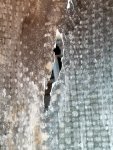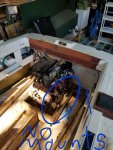madstories
Seaman Apprentice
- Joined
- Aug 28, 2017
- Messages
- 37
I am currently replacing a transom on a 1975 16 foot fiberglass boat. As I was sanding the inside, there is some spots in the corners where I could not sand down to the fiberglass. It looked like just resin. Instead I sounded straight through to the outside of the boat. I did not see any fiberglass in these areas.. All that seemed to be there was resin but I am unsure of that. I was thinking that maybe somebody put a few holes in it and repaired it without using any fiberglass material in that spot and I just happen to find it while sanding. But then I got to thinking what if the fiberglass has been too wet and somehow broke down or rotted for lack of a better term.
This is really making me wonder if the whole hull could be full of these weak spots. Does this fiberglass look normal, or is therr something wrong?
My plan is to reinforce the back with a layer of chop strand then woven roving then a final layer of chop strand which will cover the entire transom 8" past all corners. Does this sound good?
The first picture shows a small area where I could not sand down and find any woven roving I'm sure if I continue to little further it would come through to the outside like the other spots. Does anybody have any idea what I'm looking at here?
This is really making me wonder if the whole hull could be full of these weak spots. Does this fiberglass look normal, or is therr something wrong?
My plan is to reinforce the back with a layer of chop strand then woven roving then a final layer of chop strand which will cover the entire transom 8" past all corners. Does this sound good?
The first picture shows a small area where I could not sand down and find any woven roving I'm sure if I continue to little further it would come through to the outside like the other spots. Does anybody have any idea what I'm looking at here?

























